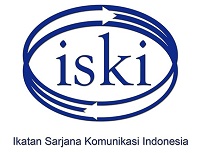Strategic Communications and Corporate Branding: a Study of Jebsen & Jessen Indonesia Group
Abstract
Corporate communications hold a vital function to maintain the company’s positive image and reputation in front of stakeholders. A corporate communications practitioner must be able to handle a variety of communication processes in an organization, including to determine the right strategy to reach its communications goal. The purpose of this research is to analyze the corporate communications strategy of Jebsen & Jessen Indonesia Group to create its corporate branding and reflect it with public relations strategic planning process. The researcher gathered the primary data from in-depth interview with key informant and combine it with secondary data from other relevant data. Afterwards, it was verified by triangulation to strengthen the credibility of data and continue with analysis process. This research concluded that Jebsen & Jessen Indonesia Group has implemented its corporate branding strategy accordingly to public relations strategic planning process. Some of the targets have been achieved in one year period, however there have been suggestions to improve the future corporate branding strategy formation.
Keywords
Full Text:
PDFReferences
Abratt, R., & Kleyn, N. (2012). Corporate identity, corporate branding and corporate reputations: Reconciliation and integration. European Journal of Marketing, 1048-1063.
Ali, I., Jime´nez-Zarco, A. I., & Bicho, M. (2015). USING SOCIAL MEDIA FOR CSR COMMUNICATION AND ENGAGING STAKEHOLDERS. Corporate Social Responsibility in the Digital Age: Developments in Corporate Governance and Responsibility, Volume 7, 165-185.
Alizadeh, A., moshabaki, A., Hoseini, S. H., & Naiej, A. K. (2014). The Comparison of Product and Corporate Branding Strategy: a conceptual framework. IOSR Journal of Business and Management, 14-24.
Austin, E. W., & Pinkleton, B. E. (2006). Strategic Public Relations Management: Planning and Managing Effective Communication Programs. New Jersey: Lawrence Erlbaum Associates, Inc.
Balmer, J. T. (2003). THE THREE VIRTUES AND SEVEN DEADLY SINS OF CORPORATE BRAND MANAGEMENT. In J. M. Balmer, & S. A. Greyser, Revealing the Corporation: Perspectives on identity, image, reputation, corporate branding, and corporate-level marketing (pp. 299-316). London: Routledge.
Beck, S. (2016). Brand management research in family firms: A structured review and suggestions for further research. Journal of Family Business Management, 225-250.
Carter, N., Bryant-Lukosius, D., DiCenso, A., Blythe, J., & Neville, A. J. (2014). The Use of Triangulation in Qualitative Research. Oncology Nursing Forum, 1.
Cornelissen, J. (2011). Corporate Communication: A Guide to Theory and Practice. London: SAGE.
Corporate Communications Jebsen & Jessen. (2016). Jebsen & Jessen Indonesia. Retrieved from Jebsen and Jessen (SEA): http://www.jjsea.com/doc/AboutUs
Creswell, J. W. (2007). Qualitative Inquiry & Research Design: Choosing Among Five Approaches. California: Sage Publications, Inc.
Daymon, C., & Holloway, I. (2011). Qualitative Research Methods in Public Relations and Marketing Communications. New York: Routledge.
Dolphin, R. R., & Fan, Y. (2000). Is Corporate Communications A Strategic Function? Management Decision, 99-106.
Đorđević, B. (2008). CORPORATE STRATEGIC BRANDING: HOW COUNTRY AND CORPORATE BRANDS COME TOGETHER. Economic Annals, 59-88.
Elving, W. J. (2012). Corporate Communication Positioned within Communication Studies – Corporate Communications, an International Journal: The Journal and its History, Scope and Future Developments. Review of Communication, 66-77.
Flick, U. (2009). An Introduction to Qualitative Research. London: SAGE Publication, Ltd.
Foster, C., Punjaisri, K., & Cheng, R. (2010). Exploring the relationship between corporate, internal and employer branding. Journal of Brand & Management, 401-409.
Goodman, M. B. (2004). Today's corporate communication function. In S. M. Oliver, Handbook of Corporate Communication (pp. 217-224). New York: Routledge.
Gray, & Balmer. (1998). Managing Corporate Image and Corporate.
Gray, E. R., & Balmer, J. M. (1998). Managing Corporate Image and Corporate Reputation. Long Range Planning, 4.
Gregory, A. (2007). Involving Stakeholders in Developing Corporate Brands. Journal of Marketing Management, 3.
Gregory, A. (2010). Planning and Managing Public Relations Campaigns: A Strategic Approach. London: Kogan Page.
Harrell, M. C., & Bradley, M. A. (2009). Data Collection Methods: Semi-Structured Interviews and Focus Groups. Santa Monica: RAND Corporation.
Herstein, R., Mitki, Y., & Jaffe, E. D. (2008). Communicating a new corporate image during privatization: the case of El Al airlines. Corporate Communications: An International Journal, 380-393.
Jebsen & Jessen (SEA). (2011). Corporate Identity Guidelines. Retrieved from Jebsen & Jessen (SEA): http://www.jjsea.com/doc/VisualIdentity
Johan, M. R., & Noor, N. A. (2013). the Role of Corporate Communication in Building Organization’s Corporate Reputation: An Exploratory Analysis. INTERDISCIPLINARY JOURNAL OF CONTEMPORARY RESEARCH IN BUSINESS, 1230-1240.
Kay, M. J. (2006). Strong brands and corporate brands. European Journal of Marketing, 12.
Keller, K. L., & Aaker, D. A. (2003). THE IMPACT OF CORPORATE MARKETING ON A COMPANY’S BRAND EXTENSIONS. In J. M. Balmer, & S. A. Greyser, Revealing the Corporation: Perspectives on identity, image, reputation,corporate branding, and corporate-level marketing (p. 272). New York: Routledge.
Kilgour, M., Sasser, S. L., & Larke, R. (2015). The social media transformation process: curating content into strategy. Corporate Communications: An International Journal, 326-343.
Knights, K. (2001). STRATEGIC PLANNING IN PUBLIC RELATIONS: A Practical Guide. London: Thorogood.
Melewar, T. C., & McCann, C. D. (2004). Facets of the global corporate. In S. M. Oliver, Handbook of Corporate Communications and PR (pp. 175-182). New York: Routledge.
Micelotta, E. R., & Raynard, M. (2011). Concealing or Revealing the Family? Corporate Brand Identity Strategies in Family Firms. Family Business Review, 197-216.
Oliver, S. (2010). Public Relations Strategy. London: Kogan Page.
Oliver, S. M., & Allen, A. C. (2004). Reputation and leadership in a public broadcast company. In S. M. Oliver, Handbook of Corporate Communication (p. 254). New York: Routledge.
Pew Research Center. (2017, January 11). Which social media platforms are most popular. Retrieved from Pew Research Center: http://www.pewinternet.org/chart/which-social-media-platforms-are-most-popular/
Podnar, K. (2015). Corporate Communications: A Marketing Viewpoint. New York: Routledge.
Rawlins, B. L. (2006). Prioritizing Stakeholders for Public Relations. Gold Standard paper of the Commission on Public Relations Measurement & Evaluation.
Riel, C. B., & Fombrun, C. J. (2007). ESSENTIALS OF CORPORATE COMMUNICATION: Implementing practices for effective reputation management. New York: Routledge.
Siano, A., Piciocchi, P., Bassano, C., Palazzo, M., Siglioccol, M., & Luca, D. D. (2014). Ingredient Branding Strategy in manufacturing sector: enhancing the value proposition. XXVI Convegno annuale di Sinergie, 269-278.
Sirisagul, K. (2015). Roles of Practitioners and Strategic Planning Practices. 2.
Smith, R. D. (2005). Strategic Planning for Public Relations. New Jersey: Lawrence Erlbaum Associates, Inc.
Steyn, B. (2002). FROM 'STRATEGY' TO 'CORPORATE COMMUNICATION STRATEGY': A CONCEPTUALISATION. International Public Relations Research, 17.
Steyn, B. (2009). The Strategic Role of Public Relations Is Strategic Reflection: A South African Research Stream. American Behavioral Scientist, 516-532.
Steyn, B., & Niemann, L. (2010). Enterprise strategy: A concept that explicates corporate communication’s strategic contribution at the macro-organisational level. Journal of Communication Management, 106-126.
Tan, M. A., Nguyen, B., Melewar, T. C., & Bodoh, J. (2015). Exploring the corporate image formation process. Qualitative Market Research: An International Joural, 87-115.
Tongco, M. D. (2007). Purposive Sampling as a Tool for Informant Selection. A Journal of Plants, People, and Applied Research, 1.
van Riel, C. B., & Fombrun, C. J. (2007). “ESSENTIALS OF CORPORATE COMMUNICATION: Implementing practices for effective reputation management”. New York: Routledge.
Vella, K. J., & Melewar, T. C. (2008). Explicating the relationship between identity and culture: A multi-perspective conceptual model. In T. C. Melewar, Facets of Corporate Identity, Communication, and Corporate Reputation (p. 11). New York: Routledge.
Vernuccio, M. (2014). Communicating Corporate Brands Through Social Media: An Exploratory Study. International Journal of Business Marketing, 211-233.
Victor, P. (2017, January 10). Corporate Communications Strategy to build Corporate Branding of Jebsen and Jessen Indonesia Group. (H. W. Lestari, Interviewer)
DOI: https://doi.org/10.29313/mediator.v10i1.2609
Refbacks
- There are currently no refbacks.

This work is licensed under a Creative Commons Attribution 4.0 International License























